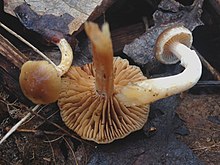Meottomyces
| Meottomyces | |
|---|---|

| |
| Scientific classification | |
| Kingdom: | |
| Division: | |
| Class: | |
| Order: | |
| Genus: | Meottomyces Vizzini (2008)[1]
|
| Type species | |
| Meottomyces dissimulans (Berk. & Br.) Vizzini (2008)
| |
Meottomyces is a small genus of relatively nondescript, fleshy, brown mushrooms related to Tubaria.[2][3][4] In older classifications it had been included in Pholiota,[5] Phaeogalera[2][6] or Hemipholiota.[3] Modern molecular evidence suggested recognition of a separate genus when sequences of a collection first identified as Pholiota oedipus, now reclassified in Meottomyces, revealed a unique branch.[4][7] Subsequently, that species was studied by Holec [8] and later as Phaeogalera oedipus was shown to be distinct from Tubaria[2][9] but not the type of Phaeogalera itself. Additional phylogenetic support was provided by Gitte Petersen and others, who clearly showed a separation from Phaeogalera.[4] The genus was erected by Vizzini[1] for two species and two varieties, all former members of Pholiota.[5] Vizzini treated the name Pholiota oedipus as a misapplied name, but this is contested by Legon[3] who provided detailed notes on the types and ecology of the type species.
The genus is named after an Italian mycologist, Francesco Meotto, who studies ectomycorrhizal fungi.
References
- ^ a b Vizzini A. (2008). "Miscellanea". Rivista di Micologia (in Italian). 1 (1): 63–66.
- ^ a b c Garnica S, Weiss M, Walther G, Oberwinkler F (2007). "Reconstructing the evolution of agarics from nuclear gene sequences and basidiospore ultrastructure". Mycological Research. 111 (Pt 9): 1019–1029. doi:10.1016/j.mycres.2007.03.019. PMID 18022533.
- ^ a b c Legon N. (2012). "Fungal portraits No. 49: Meottomyces dissimulans". Field Mycology. 13 (1): 3–7. doi:10.1016/j.fldmyc.2011.12.002.
- ^ a b c Petersen G, Knudsen H, Seberg O (2010). "Alignment, clade robustness and fungal phylogenetics — Crepidotaceae and sister families revisited". Cladistics. 26: 62–71. doi:10.1111/j.1096-0031.2009.00279.x.
- ^ a b Smith AH, Hesler LR (1968). "The North American Species of Pholiota". New York, NY: Hafner Publ. Co.
{{cite journal}}: Cite journal requires|journal=(help) - ^ Romagnesi H. (1980). "Position taxonomique de l' Agaricus oedipus Cooke". Bull. Soc. Mycol. Fr. (in French). 96 (3): 249–251.
- ^ Moncalvo JM, Vilgalys R, Redhead SA, Johnson JE, James TY, Catherine Aime M, Hofstetter V, Verduin SJ, Larsson E, Baroni TJ, Greg Thorn R, Jacobsson S, Clémençon H, Miller OK Jr (2002). "One hundred and seventeen clades of euagarics". Molecular Phylogenetics and Evolution. 23 (3): 357–400. doi:10.1016/S1055-7903(02)00027-1. PMID 12099793.
- ^ Holec J. (2003). "Taxonomy and nomenclature of Pholiota dissimulans with respect to Phaeogalera oedipus". Sydowia. 55 (1): 77–85.
- ^ Walther G, Garnica S, Weiß M (2005). "The systematic relevance of conidiogenesis modes in the gilled Agaricales". Mycological Research. 109 (5): 525–44. doi:10.1017/S0953756205002868. PMID 16018308.
External links
